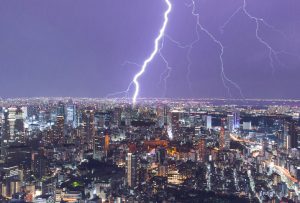
Around 100 lightning bolts strike the ground every second, and Texas gets the brunt of it. Our state leads the nation in lightning strikes, with a record 3.3 million recorded in 2017. This activity creates a problem for enterprises who find their unprotected equipment in its path. Transient power surges—which are the ones caused by lightning—are the most damaging to IP cameras as they can corrode hardware and data.
With thousands of cameras spread across hundreds of locations, large enterprises face significant financial losses from these surges. Lightning can destroy both cameras and the data they collect, which costs enterprises money and puts them at risk as critical security components go offline. All your enterprise security cameras need protection from these surges. Good security system providers make this an installation best practice.
What Happens to Your IP Camera During a Surge?
Many people assume that IP camera surge protectors are there to protect cameras from direct lightning strikes, but that’s incorrect. A single lightning bolt can contain up to 1 billion volts of electricity. There is nothing that can protect a piece of hardware from a direct hit like that. Fortunately, direct hits aren’t frequent. It’s the surges you have to take into consideration. Here’s why:
The electricity from a lightning strike doesn’t just disappear once it hits the ground. It travels until it dissipates, often finding its way to powerlines. Once in the lines, it sends a rapid increase in supply that travels straight to electronics like IP cameras. As these devices have sensitive, structurally fragile microchips, it’s very easy for even static electricity to damage them. Without proper protection, a sudden jolt of power would almost definitely destroy a device. The damage doesn’t stop there, as the power could then travel to the network switch and blow the entire system.
These surges don’t have to be noticeable or immediately damaging, either. Small, regular surges can slowly degrade a device over time. This means you will end up replacing components more often, resulting in higher cumulative system costs. Lightning strikes and surges are typically not covered under product warranties, so damage to these products comes right out of the enterprise’s bottom line. To prevent the long- and short-term impact of power supply spikes, you should be investing in surge suppression.
The Cost Savings of Installing IP Camera Surge Protectors
Surge protection works to redirect sudden voltage spikes down a less destructive path. Individual devices may have internal surge protection systems, but that’s more to combat standard fluctuations in electricity. Protecting IP cameras from surges related to lightning requires only a few additional steps that serve to protect the cameras and the network they use. An experienced security integrator will make sure that:
- A surge protector is installed and connected to a grounded conductor, typically a ground wire.
- That ground wire connects to the network switch that supplies the camera.
- When the voltage spike hits, it follows the ground wire away from the switch and hits the surge protector instead.
Surge protection is a fundamental step in installation and provides such effective cost savings, it’s a best practice. Every outdoor IP camera needs surge suppression to protect against sudden voltage spikes as well as long-term damage from smaller power fluctuations. The cost of proper installation is nominal when compared to the expense of early replacements, service calls, and business disruption related to damage from lightning.
3Sixty Integrated considers surge protection a critical component in any surveillance system and makes this an essential step in our installation process. Our camera installation blueprints work to extend the useful life of your system by leveraging tools like surge protectors to minimize device wear and tear. For more information, call (210) 545-1770 or fill out our contact form.

